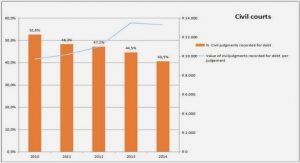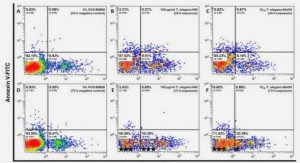Get Complete Project Material File(s) Now! »
Orthogonal polynomials and their properties
Orthogonal polynomials were used by R. Murphy (cf. [40]) in 1835 although he referred to them as ”reciprocal functions”. P.L. Chebyshev (cf. [16]) recognized the importance of orthogonal polyno- mials during the course of his work on Fourier series, continued fractions and approximation theory. The classical orthogonal polynomials are often thought to be the Jacobi, Laguerre and Hermite polynomials, which are orthogonal on the real line, with respect to the beta, gamma and normal distributions respectively. It is well known that the Jacobi polynomial P (α,β) n has a 2F1 representation, while Laguerre and Hermite polynomials have 1F1 and 2F0 representations respec- tively; so there are natural connections between these orthogonal polyno- mials and hypergeometric functions.
Gegenbauer, Chebyshev and Legendre polynomials are special cases of the Jacobi polynomial P (α,β) n . Sequences of Jacobi, Laguerre and Hermite polynomials have several useful and important differential equations on a linear lattice, a quadratic lattice, a q-linear lat- tice, or a q-quadratic lattice, and they can all be obtained as limits of the q-Racah polynomials or the Askey-Wilson polynomials. It has been shown by Atakishiyev et al. in [11] that this broader definition of classical orthogonal polynomials can also be reformulated in terms of difference equations, Ro- drigues formula and moments. Furthermore, details of the solutions to these characterization problems are worked out, such as the explicit orthogonality, boundary conditions, moments, and integral representations.
A classifica- tion of continuous and discrete classical orthogonal polynomials, based on the lattice type, is also presented. Agarwal and Manocha introduced, in [3], a sequence of polynomials de- fined by a Rodrigues type formula. They obtained linear and trilinear gen- erating functions and operational formulas. Their results generalize those of Srivastava and Singhal (cf. [54]) and also the results for the classical orthog- onal polynomials, including the Bessel polynomials via the extended Jacobi polynomials as discussed by Patil and Thakare in [41]. This is then used to establish the orthogonality of {pn(cos θ)} when {a, b, c, d} = {a1, a2, a3, a4}. The choices a + c = b + d = 0 make the weight function an even function of cos θ, and p2n(x) becomes a polyno- mial of degree n in x 2 so that p2n( √ x) are orthogonal and turn out to be another set of Askey-Wilson polynomials. This leads to a quadratic trans- formation connecting balanced 4φ3 polynomials with four free parameters. Several known special cases of the Askey-Wilson polynomials are mentioned and they include continuous q-ultraspherical and q-Jacobi polynomials and the Al-Salam-Chihara polynomials. Rodrigues type formulas are derived us- ing the finite difference operator (δqf)(e iθ) = f(e iθ√q ) − f(eiθ/√ q).
Askey and Wilson also solve the connection coefficient problem for their polynomials and make some remarks on the zeros of the polynomials. In [4], Al-Salam gives a survey of various characterization theorems for orthogonal polynomials on the real line. In addition to the standard charac- terization theorems, Al-Salam also describes the discrete cases by replacing the derivation operator with a finite difference operator and a q-difference operator. Several other orthogonal polynomial sets are thus characterized, including the Charlier, Meixner and Hahn polynomials and some of their q-analogues. In particular, it is shown that the Askey-Wilson polynomi- als have a q-difference operator such that there is a second-order difference equation. Their differences are again orthogonal polynomials and have an analogue of Rodrigues’ formula. Other characterization results given in this paper are results based on the generating function of polynomials (for Sheffer polynomials, Brenke polynomials, Fej ́er’s generalized Legendre polynomials) and a classification of polynomial sets such that the convolution is again an orthogonal polynomial set.
They also gave sufficient conditions on the interlacing of zeros (which we also define later) of Rn(x), pn(n) and pn−1(x). In addition, they dealt with the location of zeros of pn(x) + anpn−1(x) + bnpn−2(x) when an and bn are both different from zero. Stieltjes, in [52], established that for any sequence of orthogonal polyno- mials {pn}, if m < n, then there are m distinct intervals of the form (xk, xk+1) each containing one zero of pm, where xk, xk+1 are consecutive zeros of pn. Beardon and Driver, in [12], extend Stieltjes’ result to some linear combina- tions akpk + · · · + ampm, with akam 6= 0, 1 ≤ k ≤ m ≤ n. They also discuss the interlacing property of zeros of apn + bpn+1 and those of cpn + dpn+1, when ad − bc 6= 0, using the Wronskian operator. Recently, Joulak, in [36], gives characterizations of the quasi-orthogonality of order r by using linear algebra techniques. He extends the results in [15] and gives new results on the location of zeros of quasi- orthogonal polynomials.
Interlacing property
We have seen in Section 1.1, that if {pn} ∞ n=0 is a sequence of orthogonal polynomials, then for n > 0, if x1,n < x2,n < x3,n < · · · < xn,n are the zeros of pn(x) and x1,n+1 < x2,n+1 < · · · < xn+1,n+1 are zeros of pn+1, the polynomials pn and pn+1 have interlacing zeros; namely, x1,n+1 < x1,n < x2,n+1 < x2,n < · · · < xn,n+1 < xn,n < xn+1,n+1. It is interesting to note that the interlacing of zeros is meaningful outside the context of orthogonality and, in the classical situation, deals with polynomi- als of successive degree in a sequence. Obreschkoff proved (cf. [14]) that pn and qm have interlacing zeros if and only if any polynomial of the form αpn + βqm, with α ∈ R, β ∈ R, α 6= 0 or β 6= 0, has all roots real and simple.
The Hermite-Biehler Theorem and Hermite-Kakeya Theorem (cf. [44], pp.197-198) also give necessary and sufficient conditions for two non-constant polynomials with real coefficients to have interlacing zeros. Let pn(x) and qm(x) be two real polynomials. Consider the two-variable The n-order symmetric matrix B[akl] is called the Bezoutian matrix of the polynomials pn(x) and qm(x). Alvarez and Sansigre established in [6, Theorem 2] that the monic polyno- mials pn(x) and qn+1(x) have interlacing zeros if and only if the corresponding Bezoutian matrix is positive definite. In this thesis, we will investigate the interlacing property of zeros not only for polynomials of successive degrees from different orthogonal sequences, but also polynomials of the same degree from different orthogonal sequences. We shall say that two real and non-constant polynomials pn(x) and qm(x), with m = n or m = n + 1, have interlacing zeros if the zeros of pn(x) and qm(x) are all real and simple and between any two consecutive zeros of qm(x), there is exactly one zero of pn(x).
Contents
- 1 Introduction
- 1.1 Orthogonal polynomials and their properties
- 1.2 Interlacing property
- 1.3 Importance of interlacing of zeros
- 1.4 Monotonicity result
- 1.5 Interlacing of zeros of Laguerre polynomials and Gegenbauer polynomials
- 1.6 Brief overview
- 2 Interlacing of zeros of Jacobi polynomials from sequences corresponding to different parameters
- 2.1 Introduction
- 2.2 Interlacing of zeros of Jacobi polynomials of consecutive degreefrom different sequences
- 2.2.1 Some recurrence relations of Jacobi polynomials
- 2.2.2 Interlacing of zeros of Jacobi polynomials of consecu-tive degree from different sequences
- 2.3 Interlacing of zeros of Jacobi polynomials of the same degreewith different parameters
- 2.4 Conclusion
- 3 Interlacing of zeros of linear combinations of Jacobi polyno-mials from different sequences
- 3.1 Introduction
- 3.2 Interlacing of the zeros of linear combinations of different Ja-cobi polynomials with the component polynomials
- 3.3 Interlacing of the zeros of linear combinations of different Ja-cobi polynomials polynomials with other Jacobi polynomials
- 3.4 Conclusion
- 4 Interlacing of zeros of linear combinations of classical orthog-onal polynomials from different sequences
- 4.1 Introduction
- 4.2 Quasi-orthogonality and preliminary results
- 4.3 Linear combinations of Laguerre polynomials
- 4.4 Linear combinations of Jacobi polynomials
- 4.5 Conclusion and Future Research
- 5 Appendix






